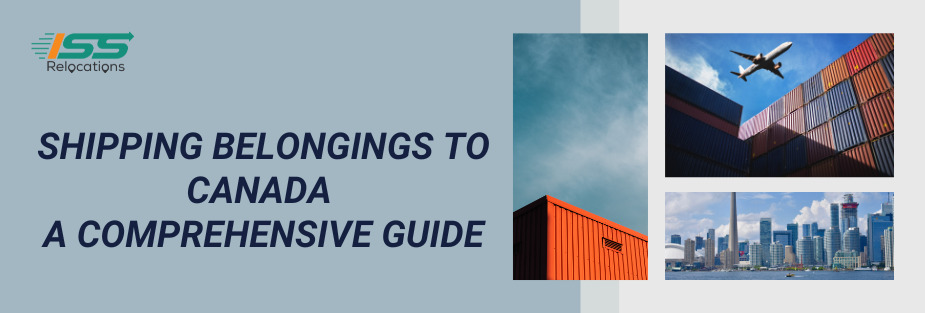Table of Contents
ToggleMoving to a new country is a thrilling adventure, but it can also be a complex process, especially when it comes to shipping belongings to Canada. This comprehensive guide aims to make your transition as smooth as possible by providing essential information on the best methods for moving your belongings to Canada, what to keep in mind during the process, and regulations regarding what you can and can’t ship. By understanding these key aspects, you can ensure a seamless relocation experience. Whether you’re relocating for work, education, or personal reasons, careful planning and preparation are crucial for a stress-free move. ISS Relocations is here to support you every step of the way, offering professional services tailored to your unique needs.
Methods for Shipping Belongings to Canada
When it comes to shipping belongings to Canada, you have several options to choose from, each with its advantages and considerations. Selecting the right method depends on various factors such as the volume of items, budget, and urgency.
Sea Freight
Sea freight is a popular choice for shipping belongings to Canada, especially if you have a large volume of goods. This method is cost-effective, making it ideal for heavy and bulky items. Shipping containers come in various sizes, allowing you to choose one that fits your needs. However, sea freight can take several weeks to arrive, so it’s important to plan accordingly if you’re not in a rush.
Air Freight
Air freight is the fastest way to move your belongings but is generally more expensive than sea freight. This method is suitable for smaller quantities of items or when you need your belongings to arrive quickly. Air freight ensures that your goods reach Canada within a few days, providing a quick and efficient solution. This option is perfect for shipping belongings to Canada when you have essential items that you need to access soon after your arrival.
Choosing the best method for shipping belongings to Canada involves weighing the cost, speed, and volume of goods. Each method has its pros and cons, so it’s essential to consider your specific needs and circumstances. With ISS Relocations, you can find tailored solutions that ensure your belongings reach Canada safely and efficiently, making your move as smooth as possible.
Preparing for the Move
Preparing for the move is a critical step when shipping belongings to Canada. Proper planning and organization can significantly ease the stress of relocation. Here are some essential steps to ensure a smooth process.
Essential Documents
When shipping belongings to Canada, it’s crucial to have all the necessary documents prepared. The BSF186 and BSF186A forms, also known as the Personal Effects Accounting Documents, are required to list the items you are bringing with you and those that will arrive separately. These forms help the Canadian Border Services Agency (CBSA) determine if any duties or taxes are applicable. Additionally, you will need to complete a declaration card upon arrival, detailing the items you are importing. Having these documents ready in advance will save you time and hassle at the border.
Packing Tips
Efficient packing is essential for the safe and secure transportation of your belongings. Start by sorting your items and deciding what you will take with you, what you will ship, and what you might leave behind or donate. Use sturdy boxes and high-quality packing materials to protect your goods. Label each box with its contents and destination room to make unpacking easier. Create an inventory checklist to keep track of all your items and ensure nothing is lost during transit. This checklist will be useful for both you and the customs officials when shipping belongings to Canada.
Insurance
Insurance is an important consideration when shipping belongings to Canada. While professional moving companies handle your items with care, accidents can happen. Comprehensive insurance coverage will provide peace of mind, knowing that your valuables are protected against loss or damage during transit. Check with your moving company about the insurance options available and choose a plan that covers the full value of your belongings. By meticulously preparing your documents, packing efficiently, and securing insurance, you can ensure a smooth and hassle-free process when shipping belongings to Canada.
What to Keep in Mind When Shipping Belongings to Canada from UAE
Understanding the regulations and requirements is crucial when shipping belongings to Canada. Being aware of customs rules, potential costs, and necessary precautions can prevent complications during your move.
Customs Regulations
When shipping belongings to Canada, it’s important to be familiar with the customs regulations. Personal items and household goods can generally be brought into Canada duty-free if they have been owned and used by you before your move. However, new items or items intended for business use may be subject to duties and taxes. Make sure to declare all items accurately on your BSF186 and BSF186A forms to avoid any issues at the border. Misdeclaring or failing to declare items can result in fines or confiscation of goods.
Restricted and Prohibited Items
Certain items are restricted or prohibited when shipping belongings to Canada. For example, firearms, explosives, and hazardous materials are not allowed. Items like alcohol and tobacco have strict regulations and may require additional permits or duties. Be sure to check the Canadian Border Services Agency (CBSA) website for a comprehensive list of restricted and prohibited items before you pack. Knowing what you can and can’t ship will help you avoid penalties and ensure a smoother customs process.
Shipping Costs and Fees
Understanding the potential costs involved in shipping belongings to Canada is essential for budgeting your move. Costs can vary depending on the shipping method, volume of goods, and distance. Sea freight is generally more affordable for large shipments, while air freight is faster but more expensive. Additionally, be aware of any fees associated with customs clearance, storage, and delivery within Canada. Obtaining quotes from multiple shipping companies and comparing their services can help you find the best option for your budget.
Insurance
Insurance is a key consideration when shipping belongings to Canada. While professional movers take care to handle your items safely, accidents can occur. Comprehensive insurance coverage will protect your belongings against loss or damage during transit. Verify the insurance options provided by your shipping company and ensure they offer adequate coverage for your valuables.
By understanding customs regulations, knowing what items are restricted or prohibited, budgeting for shipping costs, and securing insurance, you can navigate the process of shipping belongings to Canada with confidence and ease.
Get Your Free Moving Quote Today!
Begin Your Stress-Free Relocation Journey Today – Request A Quote Now!
What Can and Can't Be Shipped to Canada
When shipping belongings to Canada, it’s essential to know what items are permitted, restricted, or prohibited. This knowledge will help you avoid complications and ensure a smooth customs process.
Permitted Items
Many personal items and household goods can be shipped to Canada without any issues. These include:
- Clothing and Personal Effects: Everyday clothing, shoes, and accessories are typically allowed duty-free.
- Household Goods: Items such as furniture, kitchenware, linens, and electronics are permitted.
- Books and Media: Books, magazines, and media devices like CDs and DVDs are generally allowed.
When shipping belongings to Canada, ensure that all items are used and not new, as new items might be subject to duties.
Restricted Items
Certain items are allowed but come with specific restrictions and regulations. These include:
- Alcohol and Tobacco: Limited quantities can be brought in, but they are subject to duties and taxes. You must declare these items at the border.
- Plants and Seeds: Some plants and seeds are allowed, but they may require permits and inspection upon arrival.
- Prescription Medications: Only a limited supply for personal use is allowed, and you must have a prescription.
Before shipping belongings to Canada that fall into these categories, check the specific regulations to avoid any issues.
Prohibited Items
Some items are entirely prohibited from being shipped to Canada. These include:
- Firearms and Ammunition: Strictly regulated and typically not allowed unless you have special permits.
- Explosives and Hazardous Materials: Items like fireworks, chemicals, and flammable goods are prohibited.
- Certain Food Products: Meat, dairy, and some fresh produce are restricted to prevent the spread of diseases.
Understanding what can and can’t be shipped to Canada is crucial for a smooth relocation. Ensure you comply with all regulations to avoid fines, confiscation, or delays.
Arriving and Claiming Your Belongings
Once you have navigated the process of shipping belongings to Canada, the next step is to claim your goods upon arrival. This process involves several key steps to ensure everything goes smoothly.
On Arrival
When you arrive in Canada, you will need to present your completed BSF186 and BSF186A forms to the customs officer. These forms list all the items you are bringing into the country, both with you and those arriving later. Ensure that all items are declared accurately to avoid any issues. Customs officers will review your forms and may inspect your belongings.
For those shipping belongings to Canada that are arriving separately, make sure to retain your stamped forms, as they will be needed to claim your goods later.
Claiming Shipped Goods
Once your shipped goods arrive in Canada, you will be notified by the logistics carrier or moving company. The process to claim your belongings typically involves the following steps:
- Notification: You will receive a notification from your shipping company once your items have arrived and are ready for pickup.
- Customs Clearance: Visit the customs depot with your stamped BSF186A form to complete the clearance process. The customs officer will verify your documents and may inspect your goods to ensure everything matches the declaration.
- Delivery Arrangements: After clearance, you can either arrange for a moving company to deliver your items to your residence or pick them up yourself from the depot.
Tips for Smooth Clearance
- Be Prepared: Have all necessary documents ready and ensure they are accurately filled out.
- Stay Informed: Keep track of your shipment and stay in contact with your shipping company for updates.
- Understand Fees: Be aware of any storage fees, customs duties, or taxes that might apply, and be prepared to pay them if necessary.
By following these steps and staying organized, you can ensure a hassle-free experience when shipping belongings to Canada and claiming them upon arrival. This will help you settle into your new home smoothly and efficiently.
Knowing What You Can Bring to Canada: Regulated, Restricted, and Prohibited Items
When shipping belongings to Canada, it’s important to understand the regulations around what you can and cannot bring into the country. This will help you avoid any complications at customs and ensure a smooth transition.
Regulated Items
Certain items are regulated and can be brought into Canada under specific conditions. These include:
- Pets: Pets such as dogs and cats can be brought into Canada but must meet specific import requirements, including vaccination and health certificates.
- Vehicles: Personal vehicles can be imported, but they must comply with Canadian safety and emissions standards.
- Weapons: Firearms and other weapons are strictly regulated and require proper permits and documentation for import.
Restricted Items
Some items are restricted and may require special permits or adherence to specific regulations:
- Alcohol and Tobacco: Limited quantities of alcohol and tobacco can be imported, but they are subject to duties and taxes.
- Plant Products: Certain plants and seeds require inspection and permits to prevent the spread of pests and diseases.
- Medical Devices and Pharmaceuticals: Personal quantities of prescription medications are allowed, but you should have a prescription and possibly a doctor’s note.
Prohibited Items
Prohibited items are not allowed under any circumstances:
- Illegal Drugs: All forms of illegal drugs are prohibited.
- Obscene Materials: Items deemed obscene are not allowed.
- Endangered Species: Products made from endangered species are strictly prohibited to protect wildlife.
Knowing what items are regulated, restricted, or prohibited will help you navigate the process of shipping belongings to Canada more smoothly and avoid any legal issues or delays.
Wrapping Up
Shipping belongings to Canada can be a complex process, but with careful planning and understanding of the necessary steps, it can be managed smoothly. From choosing the best shipping method to preparing essential documents and understanding customs regulations, each step is crucial for a successful move. ISS Relocations is here to assist you, providing expert services to ensure your belongings arrive safely and efficiently. By staying informed and organized, you can make your transition to Canada a positive and stress-free experience.
Frequently Asked Questions – FAQ's
What are the best methods for shipping belongings to Canada from UAE?
The best methods for shipping belongings to Canada include sea freight for large items, air freight for faster delivery of smaller items, and courier services for personal packages.
What to keep in mind when shipping belongings to Canada from UAE?
Key considerations include preparing essential documents, understanding customs regulations, packing efficiently, and securing insurance for valuable items.
What can I and can’t I ship to Canada from UAE?
Permitted items include personal belongings and household goods; restricted items include alcohol and tobacco, which require additional permits; and prohibited items include firearms, explosives, and certain hazardous materials.
How much does it cost to ship items to Canada from UAE?
Shipping costs depend on the size, weight, and mode of transport. Typically, prices range from $1,000 to $5,000 for international shipments. ISS Relocations offers cost-effective and secure solutions for shipping belongings to Canada.
How can I bring my belongings to Canada from UAE?
You can ship belongings to Canada via sea or air freight, depending on urgency and volume. ISS Relocations manages packing, shipping, and customs clearance, ensuring your belongings arrive safely.
How can I ship large items to Canada from UAE?
Large items can be shipped to Canada using containerized sea freight or specialized cargo services. ISS Relocations provides tailored solutions for shipping belongings to Canada, ensuring secure handling and efficient delivery.
How do I move my belongings across Canada?
To move belongings across Canada, consider hiring professional movers or freight services. ISS Relocations offers expert assistance, ensuring your items are transported efficiently and securely, whether locally or internationally.














